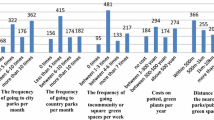Abstract
Although geo-crowdsourcing approaches provide an opportunity to collect and share environmental accessibility information for people with disabilities, it is not clear whether individuals from different user groups have similar or different behavior while contributing volunteered geographic information about environmental accessibility. In this paper, we present a case study to investigate how users (including elderly people, wheelchair users, blind and visually impaired people as well as volunteers) annotate environmental accessibility information in their journey. We found that subjects from different user groups had different behavior while annotating accessibility information and volunteers who do not have a disability are not good at spotting environmental accessibility issues. With these findings, we conclude a series of insights about how to collect collaborative environmental accessibility for designers and developers.








Similar content being viewed by others
References
Aharony, N., Pan, W., Ip, C., Khayal, I., Pentland, A.: Social fMRI: investigating and shaping social mechanisms in the real world. Pervasive Mob. Comput. 7, 643–659 (2011)
Bennett, S., Kirby, R.L., Macdonald, B.: Wheelchair accessibility: descriptive survey of curb ramps in an urban area. Disabil. Rehabil. Assist. Technol. 4(1), 17–23 (2009)
Bigham, J.P., Jayant, C., Ji, H., Little, G., Miller, A., Miller, R.C., et al.: VizWiz: nearly real-time answers to visual questions. In: Proceedings of UIST, pp. 333–342 (2010)
Coughlan, J.M., Shen, H.: Crosswatch: a system for providing guidance to visually impaired travelers at traffic intersections. J. Assist. Technol. 7(2) (2013)
Dardailler, D.: The ALT-server (“An eye for an alt”). http://www.w3.org/WAI/altserv.htm (1997)
Ding, C., Wald, M., Wills, G.: A survey of open accessibility data. In: Proceedings of the 11th Web for All, ACM, Article No. 37 (2014)
Fänge, A., Iwarsson, S., Persson, A.: Accessibility to the public environment as perceived by teenagers with functional limitations in a south Swedish town centre. Disabil. Rehabil. 24(6), 318–326 (2001)
Haklay, M., Weber, P.: OpenStreetMap: user-generated street maps. IEEE Pervasive Comput. 7(4), 12–18 (2008)
Holone, H., Misund, G., Tolsby, H., Kristoffersen, S.: Aspects of personal navigation with collaborative user feedback. In: Proceedings of Nordic Conference on Human–Computer Interaction 2008, pp. 182–191 (2008)
Goncalves, J., Kostakos, V., Hosio, S., Karapanos, E., Lyra, O.: IncluCity: using contextual cues to raise awareness on environmental accessibility. In: Proceedings of the 15th International ACM SIGACCESS Conference on Computers and Accessibility, Article No. 7 (2013)
Goodchild, M.F.: Citizens as sensors: the world of volunteered geography. GeoJournal 69, 211–221 (2007)
Kane, S.K., Bigham, J.P., Wobbrock, J.O.: Silde rule: making mobile touch screens accessible to blind people using multi-touch interaction techniques. In: Proceedings of the 10th International ACM SIGACCESS Conference on Computers and Accessibility, pp. 73–80 (2008)
Karimi, H.A., Dias, B., Pearlman, J., Zimmerman, G.: Wayfinding and navigation for people with disabilities using social navigation networks. Trans. Collab. Comput. 14(2), e5 (2014)
Katz, B., Kammoun, S., Parseihian, G., Gutierrez, O., Brilhault, A., Auvray, M., Truillet, P., Denis, M., Thorpe, S., Jourffrais, C.: NAVIG: augmented reality guidance system for the visually impaired. Virtual Real. 16(4), 253–269 (2012)
Kobayashi, M., Ishihara, T., Itoko, T., Takagi, H., Asakawa, C.: Age-based task specialization for crowdsourced proofreading. In: Proceedings of the 7th International Conference UAHCI 2013, Part II, LNCS, vol. 8010, pp. 104–112 (2013)
Kulyukin, V.A., Nicholson, J., Ross, D., Marston, J.R., Gaunet, F.: The blind leading the blind: toward collaborative online route information management by individuals with visual impairments. In: Proceedings of AAAI Spring Symposium: Social Information Processing, pp. 54–59 (2008)
Meijer, P.B.L.: An experimental system for auditory image representations. IEEE Trans. Biomed. Eng. 39, 112–121 (1992)
Nicholson, J., Kulyukin, V.: CRISS: a collaborative route information sharing system for visually impaired travelers. In: Handbook of Research on Social Dimensions of Semantic Technologies and Web Services, vol. II, pp. 720–741 (2009)
Takagi, H., Kawanaka, S., Kobayashi, M., Itoh, T., Asakawa, C. Social accessibility: achieving accessibility through collaborative metadata authoring. In: Proceedings of the 10th International ACM SIGACCESS Conference on Computers and Accessibility, pp. 193–200 (2008)
Tian, Y., Yang, X., Yi, C., Arditi, A.: Toward a computer vision-based wayfinding aid for blind persons to access unfamiliar indoor environments. Mach. Vis. Appl. 24, 521 (2012)
Ulrich, I., Borenstein, J.: The GuideCane-applying mobile robot technologies to assist the visually impaired. IEEE Trans. SMC 31, 131–136 (2001)
Völkel, T., Weber, G.: RouteCheckr: personalized multicriteria routing for mobility impaired pedestrians. In: Proceedings of the 10th International ACM SIGACCESS Conference on Computers and Accessibility (ASSETS 2008), pp. 185–192 (2008)
Weber, G. Accessibility of mobile phone applications. In: Proceedings of DEGAS 2009, Uppsala, Sweden, pp. 38–39 (2009)
WHO: Disability and health, WHO fact sheet No. 352. http://www.who.int/mediacentre/factsheets/fs352/en/ (2014)
Zandifar, A., Duraiswami, R., Chahine, A., Davis, L.: A video based interface to textual information for the visually impaired. In: Proceedings of the 4th IEEE International Conference on Multimodal Interfaces, pp. 325–330 (2002)
Zeng, L., Pescher, D., Weber, G.: Exploration and avoidance of surrounding obstacles for the visually impaired. In: Proceedings of the 14th International ACM SIGACCESS Conference on Computers and Accessibility (ASSTES 2012), pp. 111–118 (2012)
Zeng, L., Weber, G.: A pilot study of collaborative accessibility: how blind people find an entrance. In: Proceedings of the 17th International Conference on Human–Computer Interaction with Mobile Devices and Services (MobileHCI’15), pp. 347–356 (2015)
Acknowledgements
The authors would like to thank all participants for this study, as well as Dr. Völkel.
Author information
Authors and Affiliations
Corresponding author
Additional information
Limin Zeng and Romina Kühn have contributed equally to this work.
Rights and permissions
About this article
Cite this article
Zeng, L., Kühn, R. & Weber, G. Improvement in environmental accessibility via volunteered geographic information: a case study. Univ Access Inf Soc 16, 939–949 (2017). https://doi.org/10.1007/s10209-016-0505-9
Published:
Issue Date:
DOI: https://doi.org/10.1007/s10209-016-0505-9




